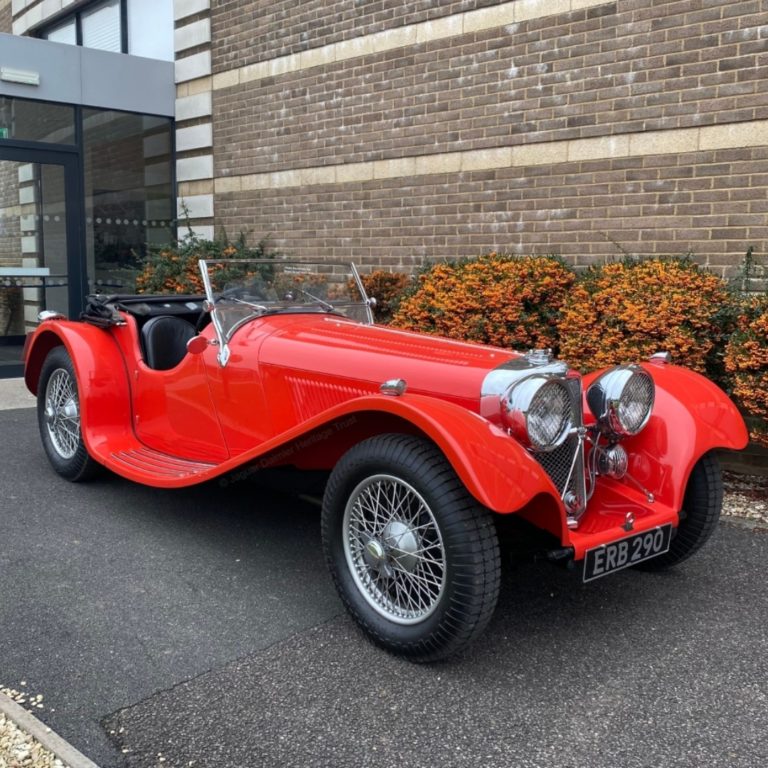
1938 SS Jaguar 100 2½ Litre ERB 290
This SS Jaguar 100 has had a fairly busy life. It was built on 20 January 1938 and despatched on 4 February. It was raced on a variety of occasions throughout 1939 by its second owner:
- Saturday 22 April – SS Car Club Buxton Trial and Rally
- Saturday 20 May – Race at Crystal Palace
- Saturday 24 June – SS Car Club Ramsgate Rally
- Saturday 26 August – Race at Crystal Palace
Originally it was painted in black with brown interior but in the 1950s it was acquired by Walter Elliott, from a local farmer by which time it had changed colour from black to cream. He had many years of fun touring Europe in what he believed was the ‘Super Car of the Day’. It then went through a few more owners before being acquired by Mr G Priest in 1968 who undertook a fairly comprehensive restoration from 1968 through to the early 1970s. This included not just mechanical work but also paintwork including its second change of colour, from cream to red and the upholstery was refurbished, changing from brown to black.
Jaguar Cars bought ERB 290 from Mr Priest in 1984 to add to its collection of historic cars in the ownership of the Jaguar Daimler Heritage Trust. The Science Museum operated PRISM fund contributed £10,000 towards this purchase.
Once in the ownership of the JDHT the car underwent some minor re-commissioning work in 1994 and has been maintained as a running, driving vehicle since then.
SS100 Background
In 1935, SS Cars for the first time produced an open two-seater sports car, the SS90. While this was a remarkably handsome car, it lacked the performance to go with its looks, as it used the side-valve Standard six cylinder engine with 70bhp as found in the SS1. In production only for a few months, a mere 23 examples of the SS90 were delivered.
The introduction in September of 1935 of the first cars to carry the ‘Jaguar’ model name was a tremendous step forward, as they were powered by a development of the old SS1 engine with an overhead valve cylinder head designed by Harry Weslake, and were fitted with twin S.U carburettors. Apart from the 2½-litre Jaguar saloon and tourer, there was the SS100 sports car. With the new 102bhp engine, and an all up weight of only 23 cwt (1170kg), the SS100 would reach a top speed of 94mph (151 km/h).
Later the SS100 was fitted with a 3½-litre version of the same engine which produced 125bhp. This version had a top speed just over the magical figure suggested by the model number, of 101mph (163 km/h). Acceleration from 0 to 50 mph (80 km/h) was a mere 7.1 seconds, and 60 mph (96 km/h) was reached in less than 9 seconds, outstanding figures for the 1930s. When new the SS100 2½-litre cost £395, and even the 3½-litre cost only £445, making it the cheapest 100mph car in Britain at the time.
In styling terms, the SS100 was similar to its SS90 predecessor, but it featured new headlamps, a revised radiator, a ‘100’ badge on the headlamp crossbar, and the ‘SS Jaguar’ badge on the radiator. At the rear of the car, the styling changes included a ‘Le Mans’ type petrol tank, with the spare wheel at an angle. A total of 191 of the 2½-litre cars were built between 1935 and 1939, with additionally 118 of the 3½-litre variant that was built from 1938 onwards, for a total production figure of 309 cars.
(Purchased in 1984 with the aid of a grant from the PRISM fund)
Registration Mark: ERB 290
Chassis Number: 49033
Owner: The Jaguar Daimler Heritage Trust
Inventory Number: 032/J.06
Price when new: £395
Price: 127 Weeks Average Wage